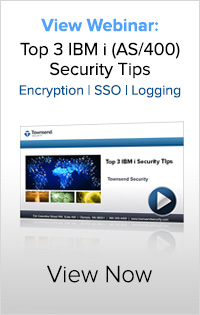
With data breaches in the news every week, and each bigger than the previous, security is a top concern for system administrators, as well as business leaders. As we have seen, a data breach can cripple an organization. While the IT team performs forensics and updates their systems, the management team has to explain to investors why they weren’t adequately prepared and break the news that “Those big plans we had to grow the business in the next two years? Yeah, those are on hold while we remediate this breach.”
While the IBM i (AS/400) is considered by many to be a secure platform, it is not immune to data breaches. As a data security company, we see plenty of organizations think they are doing the right things to keep their data safe, but are falling down on a few key areas. Below are the top three tips to keep your IBM i (AS/400) secure and your data safe:
1) Encryption and Key Management
Did you know that many compliance regulations consider an email address personally identifiable information (PII) and require it to be encrypted? Security experts recommend using NIST-certified AES encryption coupled with an external encryption key management hardware security module (HSM). With the introduction of FIELDPROC in V7R1, IT teams can now encrypt their sensitive data without application changes – saving development resources and time coming up with excuses to company leaders on why the company is still at risk.
For organizations who have been encrypting their sensitive data, security audits often find they haven’t been properly managing their encryption keys. Encryption keys should never reside on an IBM i with encrypted data. We help more enterprises than you would like to know after they fail a security audit for improper encryption key management.
2) Password Management
Password management continues to be a challenge for all organizations. Poor management leads to insecure passwords and inconsistent policies – which in turn leads to more data breaches. Fortunately for IBM i administrators, IBM realized this and made a Single Sign On (SSO) option as part of the OS – all administrators have to do is enable it. Patrick Botz, former lead security architect and founder of the IBM Lab Services security consulting practice, regularly helps organizations enable SSO and eliminate 80% or more of an organization’s password management problems just using tools that IBM provides as part of the OS. Additionally, there is a clear return on investment when an organization enables SSO, which makes you a hero when you tell management “I have a way to make our jobs easier and save money at the same time.”
3) Secure System Logging and File Integrity Monitoring
A recent study shows that 69% of data breaches could have been detected before any data was lost if proper system logging was in place. Maybe that is why most compliance regulations (PCI DSS, HIPAA/HITECH, etc.) require it. So why isn’t system logging a common practice on the IBM i? Simply put, the IBM i doesn’t log information like other systems. There are some big challenges getting security information into a usable format and transmitted to a SIEM for monitoring. Challenges an administrator faces with propriety IBM i logs:
- Data format – IBM security events are in internal IBM format, not syslog format.
- Multiple sources – Security events get collected in a variety of locations, almost always in an internal and proprietary IBM format.
- Timeliness – Tools are lacking to collect security events in real-time, increasing the security exposure.
- Communications – There are no native syslog UDP, TCP or SSL TCP communications facilities.
- Data completeness – While it is possible to print security information using IBM tools, critical information is missing from reports.
Fear not, there is a solution – Alliance LogAgent Suite with File Integrity Monitoring (FIM). Alliance LogAgent Suite can send system logs to any collection server that is listening for messages. Additionally, the FIM tools allow system administrators visibility right down to the field and column level, record-by-record, in their databases.
While this is by no means a comprehensive list of everything security-related an administrator should do to their IBM i, these three areas are where we recommend you start. If you are currently encrypting data, we challenge you find out where your encryption keys are being stored (it might scare you). If you aren’t securing your systems with SSO, what are you waiting for? Are you under a compliance regulation that requires system logging? A complete system logging solution like our Alliance LogAgent Suite can be installed and running in an hour. To hear security experts Patrick Townsend and Patrick Botz elaborate on these three IBM i security tips, view our webinar “Top 3 IBM i Security Tips.”
